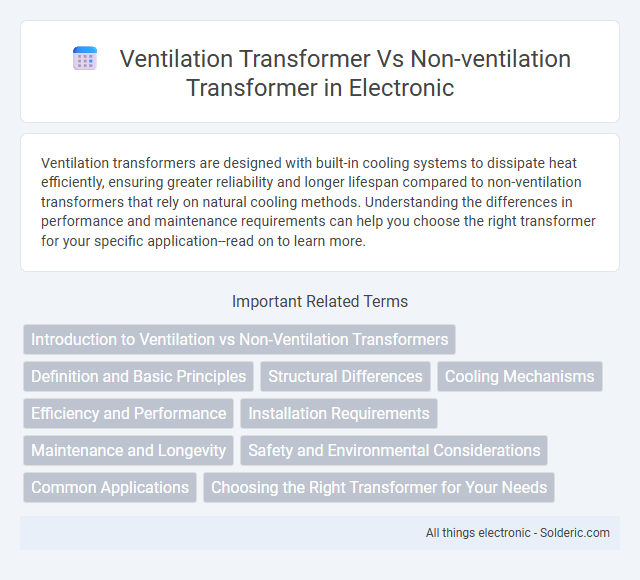Ventilation transformers are designed with built-in cooling systems to dissipate heat efficiently, ensuring greater reliability and longer lifespan compared to non-ventilation transformers that rely on natural cooling methods. Understanding the differences in performance and maintenance requirements can help you choose the right transformer for your specific application--read on to learn more.
Comparison Table
| Feature | Ventilation Transformer | Non-Ventilation Transformer |
|---|---|---|
| Cooling Method | Uses fans or blowers for active air circulation | Relies on natural air convection or oil cooling |
| Heat Dissipation | Efficient heat dissipation due to forced ventilation | Slower heat dissipation; depends on ambient temperature |
| Size & Weight | Typically larger and heavier due to ventilation components | More compact and lighter without ventilation equipment |
| Noise Level | Higher noise due to fan operation | Generally quieter with no mechanical cooling |
| Maintenance | Requires regular fan and filter maintenance | Lower maintenance, mostly inspection based |
| Application | Used in environments with high load or temperature | Suitable for low to moderate load and ambient conditions |
| Cost | Higher initial and operational cost | Lower cost due to simpler design |
Introduction to Ventilation vs Non-Ventilation Transformers
Ventilation transformers feature built-in cooling systems such as fans or air ducts that enhance heat dissipation, improving performance and lifespan under high load conditions. Non-ventilation transformers rely on natural convection and radiation for cooling, making them simpler but potentially less efficient in thermal management. Effective ventilation reduces the risk of overheating, ensuring operational stability and energy efficiency in industrial and commercial applications.
Definition and Basic Principles
A ventilation transformer is designed with built-in cooling systems, such as fans or vents, to dissipate heat and enhance performance efficiency during operation. Non-ventilation transformers rely solely on natural air circulation for cooling, making them simpler but potentially less effective in managing high thermal loads. Your choice between these types affects energy efficiency, lifespan, and suitability for different electrical load demands.
Structural Differences
Ventilation transformers feature built-in cooling systems such as fans or blowers that enhance airflow around the core and windings, reducing operating temperature and improving efficiency. Non-ventilation transformers rely on natural air convection for cooling, leading to a more enclosed and compact design but potentially higher thermal stress on components. The structural differences primarily involve the presence of vents, cooling ducts, and external cooling apparatus in ventilation transformers, which are absent in non-ventilation models.
Cooling Mechanisms
Ventilation transformers utilize air flow systems, including fans or natural convection, to dissipate heat effectively, maintaining optimal operating temperatures and enhancing efficiency. Non-ventilation transformers rely on passive cooling through natural convection and radiation without additional airflow, which may limit heat dissipation in high-load conditions. Your choice of transformer affects cooling performance, with ventilation models better suited for environments demanding improved thermal management.
Efficiency and Performance
Ventilation transformers typically offer higher efficiency by reducing operating temperature, which minimizes energy losses and prolongs lifespan, while non-ventilation transformers may experience increased thermal stress leading to reduced efficiency. Enhanced airflow in ventilation transformers improves heat dissipation, allowing for consistent performance under heavy loads, whereas non-ventilated transformers can suffer from overheating and performance degradation. Optimizing cooling through ventilation directly impacts transformer reliability and energy savings in power distribution systems.
Installation Requirements
Ventilation transformers require specific installation considerations to ensure proper airflow and cooling, including adequate spacing and positioning in well-ventilated areas to prevent overheating. Non-ventilation transformers have fewer installation restrictions but may necessitate additional thermal management solutions such as heat sinks or external cooling systems. Your choice between ventilation and non-ventilation transformers affects the complexity and cost of installation due to these differing airflow and cooling needs.
Maintenance and Longevity
Ventilation transformers feature built-in cooling systems that reduce operating temperatures, leading to decreased insulation wear and extended lifespan compared to non-ventilation transformers. Non-ventilation transformers rely on natural convection, which can result in higher maintenance frequency due to overheating risks and insulation degradation. Proper maintenance of your ventilation transformer ensures optimal performance and longevity, minimizing downtime and repair costs.
Safety and Environmental Considerations
Ventilation transformers feature cooling mechanisms that reduce overheating risks, enhancing operational safety by preventing potential fire hazards compared to non-ventilated transformers, which can accumulate heat and increase failure chances. Environmentally, ventilation transformers typically have lower thermal stress on insulation materials, extending lifespan and reducing waste, whereas non-ventilated models may require more frequent replacements, contributing to environmental burden. The selection of a ventilation or non-ventilation transformer impacts compliance with safety regulations and environmental standards, making ventilation transformers preferable in high-demand or sensitive applications.
Common Applications
Ventilation transformers are commonly used in industrial settings requiring continuous operation and efficient heat dissipation, such as manufacturing plants and power distribution systems. Non-ventilation transformers find application in residential areas or enclosed spaces where dust and moisture pose risks, often in electronic devices and smaller electrical equipment. The choice depends on environmental conditions and cooling requirements to ensure optimal performance and longevity.
Choosing the Right Transformer for Your Needs
Selecting the right transformer depends on your application's cooling requirements and environmental conditions. Ventilated transformers, equipped with fans or natural air circulation, provide enhanced heat dissipation for high-load or continuous-duty operations, ensuring improved reliability and longevity. Non-ventilated transformers are ideal for smaller loads or environments where minimal maintenance and reduced noise are priorities, offering a compact and sealed design that protects against dust and moisture.
ventilation transformer vs non-ventilation transformer Infographic

 solderic.com
solderic.com